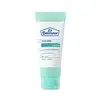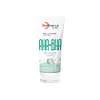What's inside
What's inside
 Key Ingredients
Key Ingredients

 Benefits
Benefits

 Concerns
Concerns

 Ingredients Side-by-side
Ingredients Side-by-side

Water
Skin ConditioningGlycerin
HumectantLauryl Hydroxysultaine
CleansingPotassium Cocoyl Glycinate
Acrylates Copolymer
Coco-Glucoside
Cleansing1,2-Hexanediol
Skin ConditioningSodium Chloride
MaskingSodium Methyl Cocoyl Taurate
CleansingSalicylic Acid 0.5%
MaskingSodium Benzoate
MaskingParfum
MaskingPotassium Hydroxide
BufferingEthylhexylglycerin
Skin ConditioningMicrocrystalline Cellulose
AbsorbentZea Mays Starch
AbsorbentDisodium EDTA
Lactic Acid 0.04%
BufferingDipropylene Glycol
HumectantCarnitine
CleansingMannitol
HumectantCapryloyl Salicylic Acid
ExfoliatingCitric Acid 0.001%
BufferingHydrogenated Lecithin
EmulsifyingWater, Glycerin, Lauryl Hydroxysultaine, Potassium Cocoyl Glycinate, Acrylates Copolymer, Coco-Glucoside, 1,2-Hexanediol, Sodium Chloride, Sodium Methyl Cocoyl Taurate, Salicylic Acid 0.5%, Sodium Benzoate, Parfum, Potassium Hydroxide, Ethylhexylglycerin, Microcrystalline Cellulose, Zea Mays Starch, Disodium EDTA, Lactic Acid 0.04%, Dipropylene Glycol, Carnitine, Mannitol, Capryloyl Salicylic Acid, Citric Acid 0.001%, Hydrogenated Lecithin
Glycerin
HumectantWater
Skin ConditioningSodium Cocoyl Glycinate
CleansingCocamidopropyl Betaine
CleansingDecyl Glucoside
CleansingCitric Acid
BufferingXanthan Gum
EmulsifyingNiacinamide
SmoothingMandelic Acid
AntimicrobialEuglena Gracilis Extract
Skin ConditioningSalicylic Acid
MaskingDextrin
AbsorbentPolydextrose
HumectantAmylopectin
Tocopherol
AntioxidantPhenoxyethanol
PreservativeChlorphenesin
AntimicrobialIngredients Explained
These ingredients are found in both products.
Ingredients higher up in an ingredient list are typically present in a larger amount.
Citric Acid is an alpha hydroxy acid (AHA) naturally found in citrus fruits like oranges, lemons, and limes.
Like other AHAs, citric acid can exfoliate skin by breaking down the bonds that hold dead skin cells together. This helps reveal smoother and brighter skin underneath.
However, this exfoliating effect only happens at high concentrations (20%) which can be hard to find in cosmetic products.
Due to this, citric acid is usually included in small amounts as a pH adjuster. This helps keep products slightly more acidic and compatible with skin's natural pH.
In skincare formulas, citric acid can:
While it can provide some skin benefits, research shows lactic acid and glycolic acid are generally more effective and less irritating exfoliants.
Most citric acid used in skincare today is made by fermenting sugars (usually from molasses). This synthetic version is identical to the natural citrus form but easier to stabilize and use in formulations.
Read more about some other popular AHA's here:
Learn more about Citric AcidGlycerin is already naturally found in your skin. It helps moisturize and protect your skin.
A study from 2016 found glycerin to be more effective as a humectant than AHAs and hyaluronic acid.
As a humectant, it helps the skin stay hydrated by pulling moisture to your skin. The low molecular weight of glycerin allows it to pull moisture into the deeper layers of your skin.
Hydrated skin improves your skin barrier; Your skin barrier helps protect against irritants and bacteria.
Glycerin has also been found to have antimicrobial and antiviral properties. Due to these properties, glycerin is often used in wound and burn treatments.
In cosmetics, glycerin is usually derived from plants such as soybean or palm. However, it can also be sourced from animals, such as tallow or animal fat.
This ingredient is organic, colorless, odorless, and non-toxic.
Glycerin is the name for this ingredient in American English. British English uses Glycerol/Glycerine.
Learn more about GlycerinSalicylic Acid (also known as beta hydroxy acid or BHA) is a well-known ingredient for treating skin that struggles with acne and clogged pores. It exfoliates both the skin's surface and deep within the pores to help clear out buildup, control oil, and reduce inflammation.
Unlike AHAs (alpha hydroxy acids), salicylic acid is oil-soluble. This allows it to penetrate into pores which makes it especially effective for treating blackheads and preventing future breakouts.
Salicylic acid is also known for its soothing properties. It has a similar structure to aspirin and can calm inflamed or irritated skin, making it a good option for acne-prone skin that is also sensitive.
Concentrations of 0.5-2% are recognized by the U.S. FDA as an over-the-counter topical acne product.
It can cause irritation and/or dryness if one's skin already has a compromised moisture barrier, so it's best to focus on repairing that before introducing this ingredient into your routine.
While salicylic acid does not increase sun sensitivity, it’s still important to wear sunscreen daily to protect your skin.
If you are looking for the ingredient called BHA or Butylated Hydroxyanisole, click here.
Learn more about Salicylic AcidWater. It's the most common cosmetic ingredient of all. You'll usually see it at the top of ingredient lists, meaning that it makes up the largest part of the product.
So why is it so popular? Water most often acts as a solvent - this means that it helps dissolve other ingredients into the formulation.
You'll also recognize water as that liquid we all need to stay alive. If you see this, drink a glass of water. Stay hydrated!
Learn more about Water